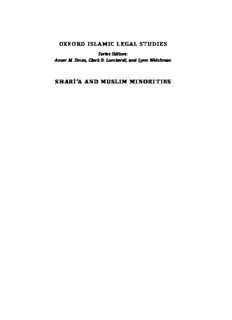Table Of ContentOUPCORRECTEDPROOF–FINAL,12/10/2015,SPi
OXFORD ISLAMIC LEGAL STUDIES
SeriesEditors:
AnverM.Emon,ClarkB.Lombardi,andLynnWelchman
SHARĪ‘A AND MUSLIM MINORITIES
OUPCORRECTEDPROOF–FINAL,12/10/2015,SPi
OXFORD ISLAMIC LEGAL STUDIES
SeriesEditors:
AnverM.Emon,ClarkB.Lombardi,andLynnWelchman
SatisfyingthegrowinginterestinIslamandIslamiclaw,theOxfordIslamicLegal
Studies series speaks to both specialists and those interested in the study of a
legal tradition that shapes lives and societies across the globe. Islamic law
operatesatseverallevels.Itshapesprivatedecisionmaking,bindscommunities,
and it is also imposed by states as domestic positive law. The series features
innovativeandinterdisciplinarystudiesthatexploreIslamiclawasitoperatesat
eachoftheselevels.Theseriesalsoshedsnewlightonthehistoryandjurispru-
dence of Islamic law and provides for a richer understanding of the state of
Islamic law in the contemporary Muslim world, including parts of the world
whereMuslimsareminorities.
OUPCORRECTEDPROOF–FINAL,12/10/2015,SPi
ī‘
Shar a and Muslim
Minorities
ṭī ī
The wasa and salaf approaches
fi ā
to qh al-aqalliyy t al-Muslima
URIYA SHAVIT
1
OUPCORRECTEDPROOF–FINAL,12/10/2015,SPi
3
GreatClarendonStreet,Oxford,OX26DP,
UnitedKingdom
OxfordUniversityPressisadepartmentoftheUniversityofOxford.
ItfurtherstheUniversity’sobjectiveofexcellenceinresearch,scholarship,
andeducationbypublishingworldwide.Oxfordisaregisteredtrademarkof
OxfordUniversityPressintheUKandincertainothercountries
©U.Shavit2015
Themoralrightsoftheauthorhavebeenasserted
FirstEditionpublishedin2015
Impression:1
Allrightsreserved.Nopartofthispublicationmaybereproduced,storedin
aretrievalsystem,ortransmitted,inanyformorbyanymeans,withoutthe
priorpermissioninwritingofOxfordUniversityPress,orasexpresslypermitted
bylaw,bylicenceorundertermsagreedwiththeappropriatereprographics
rightsorganization.Enquiriesconcerningreproductionoutsidethescopeofthe
aboveshouldbesenttotheRightsDepartment,OxfordUniversityPress,atthe
addressabove
Youmustnotcirculatethisworkinanyotherform
andyoumustimposethissameconditiononanyacquirer
CrowncopyrightmaterialisreproducedunderClassLicence
NumberC01P0000148withthepermissionofOPSI
andtheQueen’sPrinterforScotland
PublishedintheUnitedStatesofAmericabyOxfordUniversityPress
198MadisonAvenue,NewYork,NY10016,UnitedStatesofAmerica
BritishLibraryCataloguinginPublicationData
Dataavailable
LibraryofCongressControlNumber:2015953463
ISBN 978–0–19–875723–8
Printedandboundby
CPIGroup(UK)Ltd,Croydon,CR04YY
LinkstothirdpartywebsitesareprovidedbyOxfordingoodfaithand
forinformationonly.Oxforddisclaimsanyresponsibilityforthematerials
containedinanythirdpartywebsitereferencedinthiswork.
OUPCORRECTEDPROOF–FINAL,12/10/2015,SPi
To the memory of Joseph Kostiner,
a teacher, a friend, a noble soul
OUPCORRECTEDPROOF–FINAL,12/10/2015,SPi
’
Series Editors Preface
SharīʿaandMuslimMinoritiesisaworkofintellectualhistorythatoffersa
sustained analysis of two competing approaches to Islamic legal inter-
pretation among contemporary Muslims. Focusing on the fiqh al-aqal-
liyyātal-Muslima,orthefiqhofMuslimminorities,UriyaShavitlaysbare
thecontoursofboththewasaṭiyyaandsalafiyyaapproachestointerpret-
ation,andexplorestheirsubstantivedisagreementregardinglegalissues
facing Muslim minorities in Europe and North America. Drawing upon
both fieldwork andanextensive(andoftendifficulttolocate)archiveof
publications,Shavitcautionsreadersagainstmakingsimpleassumptions
about what Sharīʿa is or what Muslims believe. A work of intellectual
history, Sharīʿa and Muslim Minorities illuminates the internal debates,
conflicts, and disagreements that have led to these distinct intellectual
approaches that reflect on law and religion in the modern state. Shavit
has laid an important foundation for future research on a number of
topicsofgreatinteresttotheacademytoday.
AnverM.Emon
ClarkB.Lombardi
LynnWelchman
OUPCORRECTEDPROOF–FINAL,12/10/2015,SPi
Note on Transliterations
Book titles, institutions, and authors referenced from English-language
sourcesappearinthereferencesasintheoriginaltexts.Thus,anumber
ofnamesappearinvarioustransliterations.
OUPCORRECTEDPROOF–FINAL,12/10/2015,SPi
Introduction to Sharī‘a and Muslim Minorities
University Press Scholarship Online
Oxford Scholarship Online
Sharī‘a and Muslim Minorities: The wasati and
salafi approaches to fiqh al-aqalliyyat al-Muslima
Uriya Shavit
Print publication date: 2015
Print ISBN-13: 9780198757238
Published to Oxford Scholarship Online: December 2015
DOI: 10.1093/acprof:oso/9780198757238.001.0001
Introduction to Sharī‘a and Muslim
Minorities
Uriya Shavit
DOI:10.1093/acprof:oso/9780198757238.003.0001
Abstract and Keywords
The introduction presents the main theses of the book, its
structure, and the corpus studied. It also includes a critical
review of the existing academic literature in the field.
Keywords: wasaṭiyya, salafiyya, Muslims, religious law, Muslim minorities
The hijra, or migration, constitutes the defining moment in
Muslim history. It marks the beginning of the Muslim calendar
and the crossroads between persecution and ascendance. The
Prophet Muḥammad was forced to leave his hometown of
Mecca in AD 622 with a group of several dozen supporters and
settle in a new territory, Yathrib, which he renamed al-Madīna
and from where he continued to spread Allah’s final message.
Throughout Muslim history, both before and after the hijra,
there have been numerous instances of Muslims residing
Page 1 of 18
PRINTED FROM OXFORD SCHOLARSHIP ONLINE (www.oxfordscholarship.com). (c) Copyright Oxford University Press, 2015. All
Rights Reserved. Under the terms of the licence agreement, an individual user may print out a PDF of a single chapter of a
monograph in OSO for personal use (for details see http://www.oxfordscholarship.com/page/privacy-policy). Subscriber:
University of York; date: 12 June 2016
Introduction to Sharī‘a and Muslim Minorities
under non-Islamic rule: the migration of some one hundred
Muslims to Ethiopia in 615–16, where they found shelter
under a Christian king; the continued presence of some
Muslims in Mecca after the Prophet established a new
community in al-Madīna; and periods where millions of
Muslims resided in lands that were occupied as a result of
Christian military campaigns, from the Reconquista to modern
imperialism.
While migration constitutes the formative myth of Islam, and
while the condition of Muslims living as a minority is not a
novelty in Islamic history, the movement of millions of
Muslims to Western lands since the end of the Second World
War presented jurists with a new conceptual challenge. The
Muslims who migrated to Ethiopia did so when no Muslim
state existed and with the blessing of the Prophet. The hijra
led by the Prophet transferred believers from one infidel
society to another, where their prospects were better. The
Muslims who remained in Mecca after the hijra were natives of
the town and had the Prophet’s consent. Muslims who
continued to live under Christian occupiers clung to ancestral
lands and some had no alternative but to stay put. Post-Second
World War migration to the West was the first time in history
in which masses of (p.2) Muslims voluntarily and individually
left Muslim lands and settled in non-Muslim lands, in most
cases for the purpose of improving their economic situation.
Thus, their choice created an unprecedented theological-
juristic challenge of legitimacy.
Adding to this fundamental difficulty were those migrants’
encounters with numerous modern and post-modern norms
that appeared to conflict with Islamic norms. These ranged
from the permissibility of naturalization in secular Western
states to that of celebrating Valentine’s Day, to that of
eschewing fasting during Ramaḍān to pursue careers as
professional athletes. Some religio-juristic difficulties resulted
from attacks on multiculturalism and from anti-Muslim
sentiments that proliferated in the West, particularly during
the 2000s. Some resulted from cultural divides between
integrated second-generation Muslim migrants and the first
generation. Still other challenges resulted from financial
Page 2 of 18
PRINTED FROM OXFORD SCHOLARSHIP ONLINE (www.oxfordscholarship.com). (c) Copyright Oxford University Press, 2015. All
Rights Reserved. Under the terms of the licence agreement, an individual user may print out a PDF of a single chapter of a
monograph in OSO for personal use (for details see http://www.oxfordscholarship.com/page/privacy-policy). Subscriber:
University of York; date: 12 June 2016
Description:Based on a study of thousands of religious decisions (fatwas) and juristic treatises, the book examines the ideologies and methodologies of two contesting approaches to the religious law of Muslim minorities (fiqh al-aqalliyyāt al-Muslima): the pragmatic and integration-minded wasaṭī, and the ri

